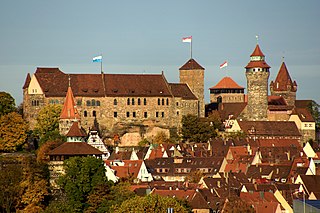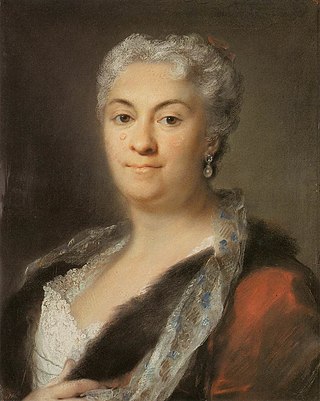Related Research Articles

Albrecht Dürer, sometimes spelled in English as Durer, was a German painter, printmaker, and theorist of the German Renaissance. Born in Nuremberg, Dürer established his reputation and influence across Europe in his twenties due to his high-quality woodcut prints. He was in contact with the major Italian artists of his time, including Raphael, Giovanni Bellini, Fra Luca Pacioli and Leonardo da Vinci, and from 1512 was patronized by Emperor Maximilian I.

Nuremberg is the largest city in Franconia, the second-largest city in the German state of Bavaria, and its 544,414 (2023) inhabitants make it the 14th-largest city in Germany.

The Holy Lance, also known as the Spear of Longinus, the Spear of Destiny, or the Holy Spear, is alleged to be the lance that pierced the side of Jesus as he hung on the cross during his crucifixion. As with other instruments of the Passion, the lance is only briefly mentioned in the Christian Bible, but later became the subject of extrabiblical traditions in the medieval church. Relics purported to be the lance began to appear as early as the 6th century, originally in Jerusalem. By the Late Middle Ages, relics identified as the spearhead of the Holy Lance had been described throughout Europe. Several of these artifacts are still preserved to this day.

The Bridgettines, or Birgittines, formally known as the Order of the Most Holy Saviour, is a monastic religious order of the Catholic Church founded by Saint Birgitta in 1344 and approved by Pope Urban V in 1370. They follow the Rule of Saint Augustine. There are today several different branches of Bridgettines.

Monica was an early North African Christian saint and the mother of Augustine of Hippo. She is remembered and honored in the Catholic and Orthodox Churches, albeit on different feast days, for her outstanding Christian virtues, particularly the suffering caused by her husband's adultery, and her prayerful life dedicated to the reformation of her son, who wrote extensively of her pious acts and life with her in his Confessions. Popular Christian legends recall Monica weeping every night for her son Augustine.

The Nuremberg Chronicle is an illustrated encyclopedia consisting of world historical accounts, as well as accounts told through biblical paraphrase. Subjects include human history in relation to the Bible, illustrated mythological creatures, and the histories of important Christian and secular cities from antiquity. Finished in 1493, it was originally written in Latin by Hartmann Schedel, and a German version was translated by Georg Alt. It is one of the best-documented early printed books—an incunabulum—and one of the first to successfully integrate illustrations and text.

Adam Kraft was a German stone sculptor and master builder of the late Gothic period, based in Nuremberg and with a documented career there from 1490.

A pomander, from French pomme d'ambre, i.e., apple of amber, is a ball made for perfumes, such as ambergris, musk, or civet. The pomander was worn or carried in a case as a protection against infection in times of pestilence or merely as a useful article to modify bad smells. The globular cases which contained the pomanders were hung from a neck-chain or belt or attached to the girdle, and were usually perforated in a variety of openwork techniques and made of gold or silver. Sometimes they contained several partitions, in each of which was placed a different perfume.

Willibald Pirckheimer was a German Renaissance lawyer, author and Renaissance humanist, a wealthy and prominent figure in Nuremberg in the 16th century, imperial counsellor and a member of the governing City Council for two periods. One of the most important cultural patrons of Germany in his own right, he was the closest friend of the artist Albrecht Dürer, who made a number of portraits of him, and a close friend of the great humanist and theologian Erasmus.

The Apocalypse, properly Apocalypse with Pictures, is a series of fifteen woodcuts by Albrecht Dürer published in 1498 depicting various scenes from the Book of Revelation, which rapidly brought him fame across Europe. These woodcuts likely drew on theological advice, particularly from Johannes Pirckheimer, the father of Dürer's friend Willibald Pirckheimer.

Adam and Eve is the title of two famous works in different media by Albrecht Dürer, a German artist of the Northern Renaissance: an engraving made in 1504, and a pair of oil-on-panel paintings completed in 1507. The 1504 engraving depicts Adam and Eve in the Garden of Eden, surrounded by several symbolic animals. The engraving transformed how Adam and Eve were popularly depicted in art.

Self-Portrait is a panel painting by the German Renaissance artist Albrecht Dürer. Painted early in 1500, just before his 29th birthday, it is the last of his three painted self-portraits. Art historians consider it the most personal, iconic and complex of his self-portraits.

Knight, Death and the Devil is a large 1513 engraving by the German artist Albrecht Dürer, one of the three Meisterstiche completed during a period when he almost ceased to work in paint or woodcuts to focus on engravings. The image is infused with complex iconography and symbolism, the precise meaning of which has been argued over for centuries.

Katerina Lemmel, OSsS was a successful German patrician businesswoman in Nuremberg who became a Bridgettines nun at the monastery of Maria Mai in Maihingen in Nördlinger Ries. A collection of letters that she wrote from the monastery to her relatives in Nuremberg permits multifaceted insights into life in a late-medieval female monastery and into its system of spiritual economies.

Christ among the Doctors is an oil painting by Albrecht Dürer, dating to 1506, now in the Museo Thyssen-Bornemisza, Madrid, Spain. The work belongs to the time of Dürer's sojourn in Italy, and was according to its inscription executed incidentally in five days while he was working on the Feast of the Rosary altarpiece in Venice. The work was influenced by Leonardo da Vinci and possibly based on the most probably earlier painting by Cima da Conegliano on the same theme.

Portrait Diptych of Dürer's Parents is the collective name for two late-15th century portrait panels by the German painter and printmaker Albrecht Dürer. They show the artist's parents, Barbara Holper and Albrecht Dürer the Elder, when she was around 39 and he was 63 years. The portraits are unflinching records of the physical and emotional effects of ageing. The Dürer family was close, and Dürer may have intended the panels either to display his skill to his parents or as keepsakes while he travelled soon after as a journeyman painter.

Women were professionally active in the academic discipline of art history in the nineteenth century and participated in the important shift early in the century that began involving an "emphatically corporeal visual subject", with Vernon Lee as a notable example. It is argued that in the twentieth century women art historians, by choosing to study women artists, "dramatically" "increased their visibility". It has been written that women artists pre-1974 were historically one of two groups; women art historians and authors who self-consciously address high school audiences through the publication of textbooks. The relative "newness" of this field of study for women, paired with the possibility of interdisciplinary focus, emphasizes the importance of visibility of all global women in the art history field.

Agnes Dürer née Frey (1475–1539) was the wife of the German artist Albrecht Dürer. During their marriage, which was childless, she was portrayed several times by Dürer.
Georg Ulrich Großmann is a German art historian. He was general director of the Germanisches Nationalmuseum in Nuremberg.

The Kinship of Christ from Prunéřov is a linden wood relief from the period 1500–1510. It is located in the permanent exhibition of the Regional Museum in Chomutov.
References
- ↑ "Corine Schleif | School of Art". art.asu.edu. Archived from the original on 2017-04-01. Retrieved 2017-03-31.
- ↑ "Faculty Spotlight: ACMRS Affiliate Prof. Corine Schleif | ACMRS". acmrs.org. Archived from the original on 2017-04-01. Retrieved 2017-03-31.
- ↑ "Corine Schleif - American Academy". American Academy. Archived from the original on 2017-04-01. Retrieved 2017-03-31.
- ↑ "opening the Geese Book". geesebook.asu.edu. Archived from the original on 2017-03-24. Retrieved 2017-03-31.
- ↑ "Extraordinary Sensescapes". sensescapes.asu.edu. Archived from the original on 2017-04-01. Retrieved 2017-03-31.
- ↑ Schleif, Corine (1998). "The Role of Women in Challenging the Canon of 'Great Master' Art History". In Amussen, Susan Dwyer; Seeff, Adele F. (eds.). Attending to Early Modern Women. U of Delaware P. ISBN 9780874136500.